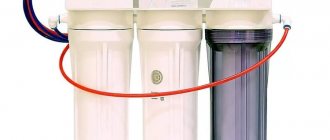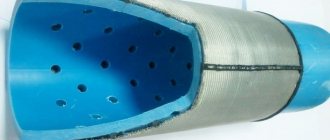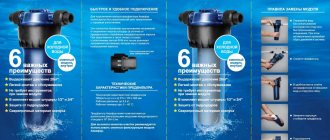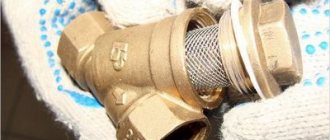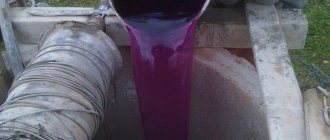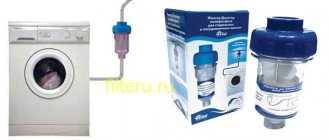2021
| no comments
So, after cleaning the flasks, lids and replacing the cartridges, all we have to do is open the water supply tap to the filter located under the sink.
In everyday life, many people use various filters to purify water. They differ in design, shape and cleaning method. However, almost all household water filters are very similar to each other. This means that the question “ how to change a water filter ” can to some extent be considered universal. So, let’s try to figure out how to change a water filter with your own hands. Let's look at this using cartridge filters as an example. After all, they are the ones who most need periodic replacement of filter elements. In other words, an important issue for us in this case is replacing the cartridge used in reverse osmosis devices and mechanical filters. But before we understand this issue, we first need to find out what a cartridge filter consists of. As the name suggests, the main working element of this filter is the cartridge. What is it? As a rule, a cartridge is a cylinder made of some kind of filter element, which can be activated carbon, polypropylene, polyethylene, etc., depending on the tasks performed (mechanical cleaning, removal of chlorine, organics, etc.). d.).Usually this cylinder contains a cavity in the center intended for purified water. The cartridge, with the exception of mechanical cleaning filters, is closed at the ends with rubber sealing rings. These rings, adjacent to the protrusions on the filter body, do not allow the source water to pass into the clean water channel. The flask (lower part of the filter) is attached to the filter “head” using a thread.
Stages of replacing a cartridge in a purifier
Well, we figured out the design of the cartridge filter. Accordingly, to replace the replacement cartridge in the filter , you must perform the following steps: → Shut off the water supply to the filter. If for some reason there is no shut-off tap, it is necessary to turn off the water supply to the entire house.→ Using the tap that should be included with the filter, you need to unscrew the flask. Pressure from inside the filter may prevent it from unscrewing. Therefore, before this you need to reset it using the pressure release button located on the “head” of the cartridge filter. If there is no such button, then you can relieve the pressure by opening the tap after the filter (clean water supply tap). You must unscrew the flask very carefully so that water does not splash out of it.→ Remove the old cartridge. It is necessary to check the rubber seals located at the ends of the cartridge (except for mechanical cleaning filters). If they are elastic and soft, then you can remove them, wash them and leave them for further use. Of course, replacement rubber bands are also sold with new cartridges, but they are often very hard and tight. → Pour the remaining water out of the flask and rinse it with water. If you have to turn off the water to your home before replacing the cartridge, you need to fill a bucket of water in advance. The flask may contain mucus and rust. It is recommended to wash the flask without using detergents, so that later they do not harm subsequent stages of filtration or get into your cup along with drinking water. You can also wipe those parts of the filter head that are accessible.→ Place a new replacement cartridge in a clean flask.
As I already said, if the rubber bands of a new replacement cartridge are hard and inelastic, then it is advisable to replace them with as soft ones as possible. If there are no soft rubber bands, then you will have to make a lot of effort to tighten the filter. Just be careful not to break the key, most importantly don’t rush.
→ Screw the flask all the way with a wrench. If we are dealing with a reverse osmosis (or ultrafiltration) apparatus, then it is advisable to fill the washed flask with a new replaceable filter installed in it with clean water prepared in advance, otherwise air bubbles in the water can harm the membrane. When replacing a cartridge in a regular (non-membrane) filter, the situation is simpler: the air will come out through the tap without any problems. → After replacing all the necessary cartridges in our system, we need to check the tightness of all connections and the quality of our water. To do this, you should smoothly, without sudden movements, open the tap to supply water to the filter. Make sure that water does not begin to seep between the filter head and the flask. If water does seep in, then you need to turn off the water again and try to tighten the flask even more tightly.
If the filter still leaks, then you will have to unscrew the flask again and check whether the thin rubber O-ring sealing ring located in the hollow of the flask is not twisted.
This is what is necessary to ensure that water does not leak out of the filter. If the ring is damaged, then you need to replace it with a new one and re-tighten the flask. It is very important after replacing the filters to drain all the purified water for about 10 minutes, thereby washing out the small particles of dust that are contained in new, especially carbon, cartridges.
In such a situation, the pressure arising in the pipeline is able to overcome the stiffness of the spring, which causes its compression and the opening of the hole for water flow by the shut-off element.
System Features
The design is mainly designed to eliminate the entry of dense and large contaminants into the central supply, such as scale from metal pipes, sand, clay particles, silt deposits, mechanical and colloidal substances. Unlike cartridge ones, they are the most reliable and in demand, since they do not require periodic replacement of blocks or manual cleaning. This ensures a guaranteed supply of drinking liquid to residents during the flushing process, as this allows the supply to continue. The procedure occurs so quickly that it saves time and money during the service period.
What will happen to the equipment if its existence is forgotten?
It will remind you of itself when the taste of the liquid changes or the supplied stream decreases to a minimum size. After unscrewing the flask and removing the block, you will see terrible brown mud deposits and smell a putrid smell. You can buy new elements and replace them according to the scheme we described above. But try to do the treatment yourself using improvised means (citric or formic acid, vinegar or ammonia) at home.
How does a water wash filter work?
Installing this system will be an excellent solution for residents of multi-storey buildings connected to a common main pipe. This will improve the quality of the incoming flow (cold and hot), avoid failure of household appliances and preserve general plumbing equipment.
But it is necessary to take into account that a third of the population lives in rural areas. When building a private cottage or dacha, each owner wants to dig and equip his own well. At the same time, many people try to save on design documentation and geodetic exploration. Therefore, when creating a mine, they do not take into account the depth of groundwater, the type of strata through which it passes, and many other nuances. In addition, independent wells do not have a properly reinforced bottom and cleaning layer. Due to errors during construction, the owner receives cloudy moisture with a large number of unwanted impurities, unsuitable for cooking and quenching thirst. There is only one way out of this situation - to assemble a high-quality filtration system.
The operating principle of this design is very simple and understandable to a person who does not have a special technical education.
The set consists of:
- Flasks with two pipes: for liquid inlet and outlet.
- Inside the container there is a mesh with cells in the form of a cylinder.
- A rotary valve is located in the lower outlet.
- Various modifications contain additional elements: pressure gauge, flushing drive or other automatic devices.
The advantage of self-cleaning water filters is their long service life and extreme ease of maintenance. Because the product consists of a minimum number of parts and has no consumables that require replacement. The liquid passing through the volume is filtered by a membrane. Solid particles settle to the bottom of the flask. This occurs by changing the flow rate. This design is well known to motorists from the example of a gasoline cleaning device with a sump. Removal of accumulated debris occurs either through a special hole in the bottom of the container or by unscrewing the entire eggplant. Depending on the type, some modifications may include backwashing.
In other filter designs that do not have a self-cleaning function, a lot of effort has to be made.
To do this you need:
- Shut off the water supply system for a while.
- Unscrew the product body.
- Remove the mesh block and rinse it under high pressure.
- Dry the part and reassemble the device in reverse order.
Terms of use
In order for the filtration system to optimally perform its function, you need to make sure that the water fully complies with the conditions for using such a device.
It is not advisable to install the cleaning system near heating systems. It is also necessary to monitor the pressure in the system: if there is high pressure in the system, the filter may fail, and you will spend a lot of money on repairs.
When using such a cleaning filter regularly, it is necessary to wash the mesh. Flushing should be carried out approximately every six months. If washing is necessary earlier, then this can be easily determined by the water pressure, and if the flasks with cleaning elements are transparent, then you can see the degree of contamination.
In order to wash safely, it is necessary to use the specified amount of water to wash the mesh. If the amount of water is increased, then some element of the system may fail.
There are many water purification systems sold in our markets, but choosing the right option for you is difficult without a specialist. And you also shouldn’t install such systems yourself. It is better to use the services of specialized companies. Such companies will provide you with a large list of their services.
An overview of some models of self-cleaning water filters can be seen below.
Varieties
It is difficult for the average person to independently understand the intricacies of the process. We advise you to contact competent companies to avoid mistakes and excessive spending of money. Our specialists will help you choose the most correct option from the five we offer.
Mesh mechanical washing self-cleaning filter for rough water purification
MBFT-75 Membrane for 75GPD
SF-mix Clack up to 0.8 m3/h
SF-mix Runxin up to 0.8 m3/h
It is characterized by preliminary cleansing of large and colloidal inclusions (sand, clay, fine gravel, stones, silt deposits, pieces of rust). It also simultaneously protects pumping equipment from damage and premature wear. The incoming liquid passes through the barrier mesh and exits purified through the drain. The reason for washing the product is a decrease in flow or when the timer goes off. To do this, the operator opens the valve and activates the scanner, where a high-pressure jet extracts and sweeps away the accumulated deposits.
Advantages of mesh structures:
- simplicity and reliability;
- high wear resistance;
- cleaning efficiency;
- operating temperature up to 90 degrees;
- exclusion of chemical reagents;
- possibility of flushing without disconnecting from the central supply;
- During the cleaning procedure, filtration remains at the same level.
Disk
Modern technologies have made it possible to create the highest quality and most efficient model, where the main component is plastic discs (not subject to corrosion and not destroyed during long-term use). When they are compressed, a container (filter element) is formed, resembling a cylinder, with thin holes through which purified moisture enters. Contamination remaining on the surface is removed by washing.
The scope of application of the product is very wide. It is used:
- in the preliminary filtration of sources with a high sand content;
- for cooling systems in industrial heat exchangers;
- at filtration stations to return purified liquid to the head of structures;
- for breeding river fish on farms.
The advantages include:
- reliability;
- tightness;
- small sizes with high filtration volumes;
- automation of the process;
- ease of operation and maintenance;
- continuity of operation during flushing.
Hand washable fine filter
Some models do not have a timer for automatic rinsing. But this does not in any way affect the efficient operation of the system. It is possible to carry out cleaning actions without stopping the filtering activity of the flow. At the bottom of the kit there is a tap for washing the mesh from dirt. When started manually, the operation lasts only half a minute, provided there is sufficient liquid pressure.
Semi-automatic
Designs with scanner additional equipment have a number of advantageous qualities along with manual cleaning:
- used in various spheres of the national economy;
- capable of producing high-quality liquid from various sources (lakes, rivers, ponds, settling tanks and others);
- a mesh made of stainless steel is capable of trapping the largest particles. Withstands high pressure flow;
- The washing process takes only a few seconds. The operator opens the flush valve and rotates the handle. At this time, the barrier's suction nozzles remove dirt deposits. In this case, the inside of the mesh is completely cleared of plaque;
- productivity directly depends on the quality of incoming moisture and the degree of filtration;
- this system has a low cost. This allows a family with a small budget to purchase goods.
Self-cleaning water filters with automatic flushing
SF-mix manual up to 0.8 m3/h
AMETHYST - 02 M up to 2 cubic meters/day.
Aeration unit AS-1054 VO-90
The operating principle of this complex is as follows:
- In order for the ball valve to rotate, a special automation equipped with a drive is installed.
- The system is equipped with a programmed timer or differential flow pressure sensor. The signal triggers additional equipment and starts the washing process.
- When the tap opens, the stream passes through certain sections of the mesh. At this time, the rotating turbine accelerates the flow, which washes all accumulated sediments into a special pan or sewer system. In this case, the supply of filtration liquid does not stop for a minute.
As a rule, due to its high cost, this type is installed on industrial highways.
Top models
To illustrate what an ideal filter for hot water purification should look like and what technical characteristics it should have, below the reader is invited to familiarize itself with the list of top models of mains devices.
Geyser Typhoon 10 SL
pros
- appearance
- compactness
- Possibility of washing without removing the cartridge
- the presence of a connector for installing a device that measures pressure in pipes
- quality of materials used in production
- effective “destruction” of rust
Minuses
- impossibility of installing the device at a low level due to its internal design
- overall dimensions
- complexity of the direct mounting system
From 3990 ₽
Aquaphor AquaBoss 1-02
pros
- proven manufacturer
- compactness
- high-quality performance of its direct functions
Minuses
- low structural strength
- inclusion of glass fiber in the filter housing, which is hazardous to human health
From 1379 ₽
Honeywell FF 06 1/2″ AAM
pros
- proven manufacturer
- compactness
- durable material used to make the case
- presence of direct flush valve
- Possibility of mounting the filter in a pipe in several ways
Minuses
- expensive to replace built-in cartridge
- does not cope with the removal of lime deposits
- impossibility of installing additional equipment for measuring pressure in pipes
From 3894 ₽
Geyser Typhoon 20 BB filter
pros
- Damage-resistant stainless steel housing
- possibility of comprehensive cleaning
- automatic regeneration of the cleaning component
- creates good pressure and water pressure at the outlet
Minuses
- high price
- passing lime when “treating” dirty running water
- poor ergonomic properties
- difficulties in attaching the filter to the pipe
From 10300 ₽
Advantages and disadvantages of self-cleaning
All of the above modifications have a number of advantages:
- The simplicity of the design allows for easy installation and further maintenance.
- It is easy to find and replace parts if the equipment becomes unusable.
- The system is made from environmentally friendly materials, which does not harm human health and the environment.
- Low power consumption.
- High performance.
- Maintenance is carried out over a long period of time.
- Many models are equipped with a water hammer protection system and elements that reduce flow pressure.
The disadvantages include the high cost of the product. Some types require the presence of a person to regulate the operation of this structure.
Leading filter manufacturers
Since the times of the Soviet Union, it is still believed that foreign products are of higher quality and more efficient. Let’s not dispel this statement, because there is a grain of truth in this. Only American products from Honeywell, for example, cost incredible amounts of money. Russian manufacturers produce cleaning devices that are in no way inferior to their Western counterparts and even superior in performance, adapted to “our” sources. Find organizations involved in the production and sale of cleaning systems. Call managers, for example, and they will give you a free consultation on each model.
Installation methods
Regardless of which option you choose, you must carry out all actions according to the instructions included with the equipment. Follow the safety rules for connecting the structure to the water supply.
Main table dispenser AquaPro 919H/RO (hot and cold water)
Main table dispenser AquaPro 929CH/RO (cooling/heating)
Floor dispenser AquaPro 311 (empty, without cooling)
When installing, comply with technical and sanitary standards:
- The system must be located in a heated room, since at low temperatures the liquid freezes and can lead to breakdown of the complex.
- On the lid of the flask you will find an arrow that indicates the direction of flow. The important task is not to confuse the sides.
- On vertical sections, installation is carried out in the direction of water flow from top to bottom.
- When purchasing a model with automatic flushing, you must have access to an electrical connection.
The fittings are selected according to the documentation and parameters of the home plumbing system. The joints of pipes and pipes are reinforced with fum tape or linen tow. After completing all the steps, a check is made by temporarily turning the pressure on and off. If there are no leaks, then the equipment is ready for continuous operation.
Principle of operation
Basically, self-flushing water purification systems have meshes. In such cases, the water is purified by passing through their cells. Fine mesh nets stop all contamination. Thus, dirt accumulates on them. This accumulated layer of dirt interferes with the normal passage of water, so the water pressure decreases.
The easiest way to remove accumulated dirt from the mesh is to remove the mesh from the flask and rinse it under running water, and then install it in its place. This work is not difficult, but it takes some time.
But to do this, you need to open the bottom valve and wait for the result. After opening the tap, water under its own weight begins to flow into the lower hole and thus washes and removes dirt from the mesh. If you did not take care of designing the outlet when installing the system, then during the cleaning period you will have to periodically change the container into which the dirt and water will be drained.
What are the types of breakdowns and methods for eliminating them?
The main problem for owners of apartments, houses or cottages are the pipe connections and the shut-off valve. Over time, these elements fail due to constant contact with an aggressive environment. These parts need to be replaced.
The second most common problem is white liquid coming out. This happens when starting a new system or when replacing filter parts due to accumulated air, which will eventually come out on its own.
Fluid may leak due to improperly tightened fittings. In this case, you need to check the connections.
Water flows slowly. The culprits may be a faulty autoswitch or a clogged osmotic membrane. Here it is necessary to replace the elements. The second reason may be that the pipeline is clogged with contaminants. The solution to the problem is to inspect and remove deposits.
If you discover a malfunction, you can make repairs with your own hands. To do this, you will need to carefully study the instructions included with the kit.
